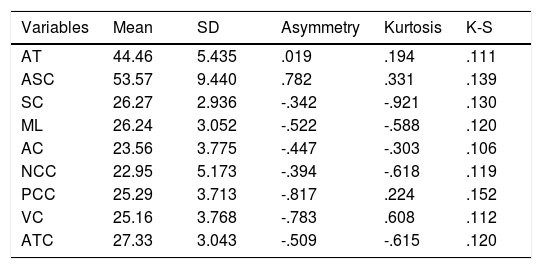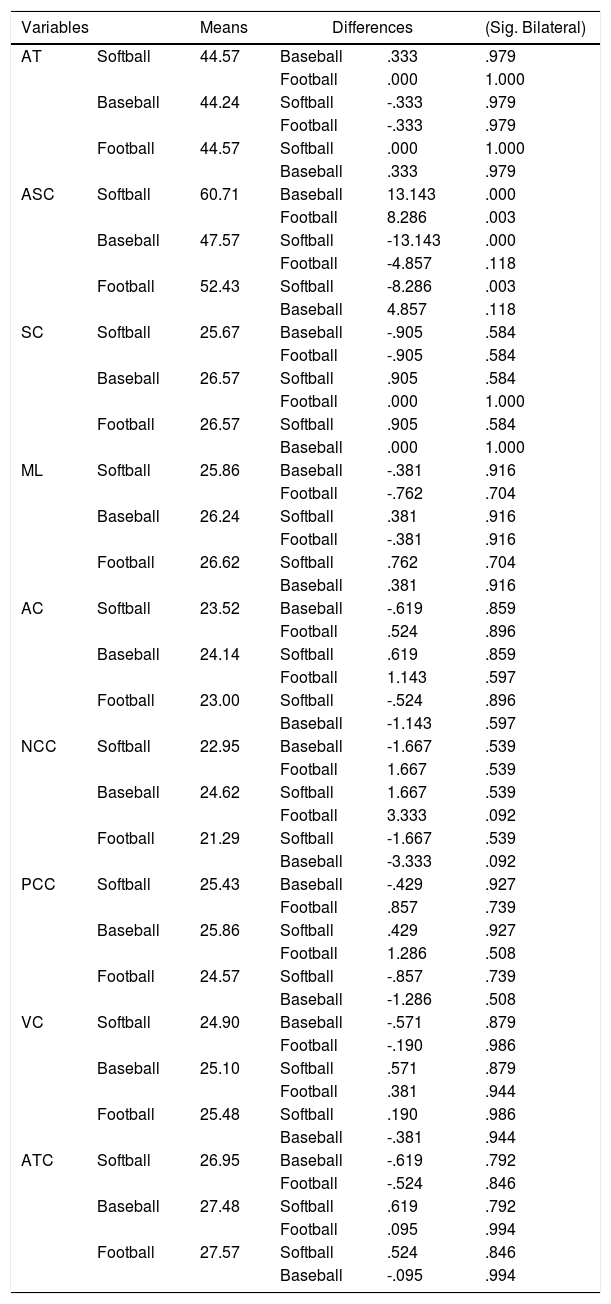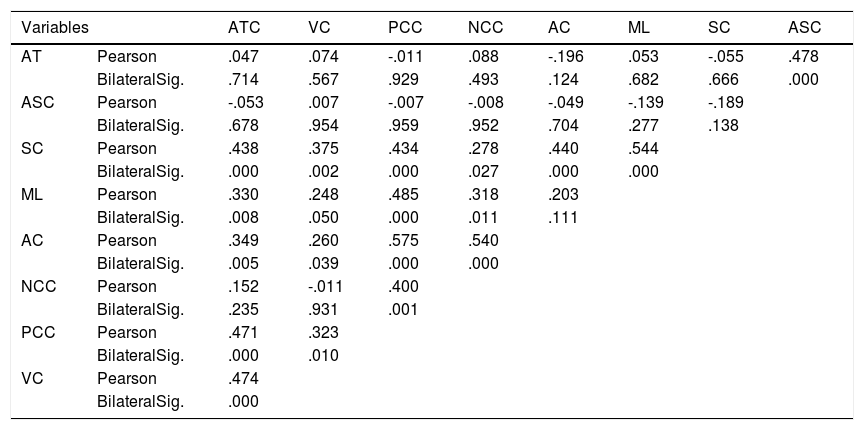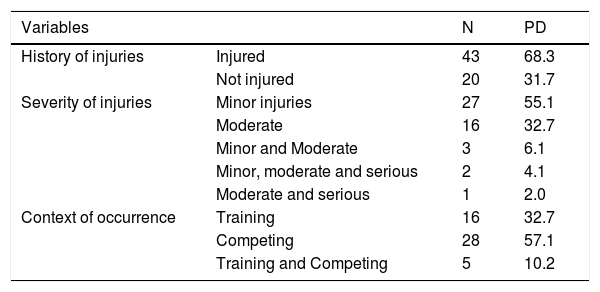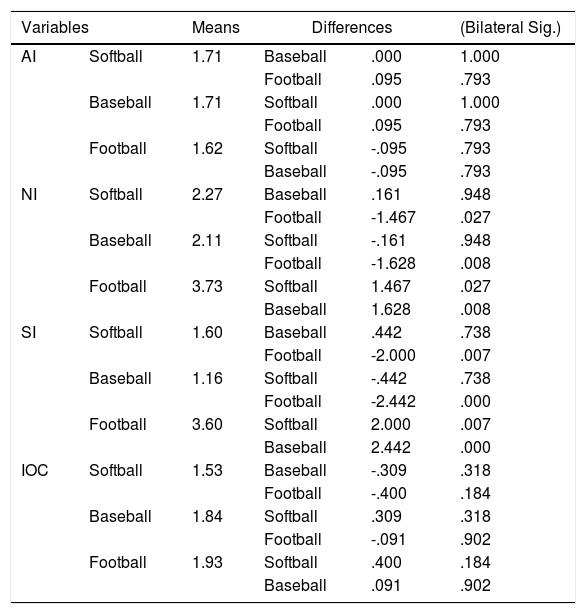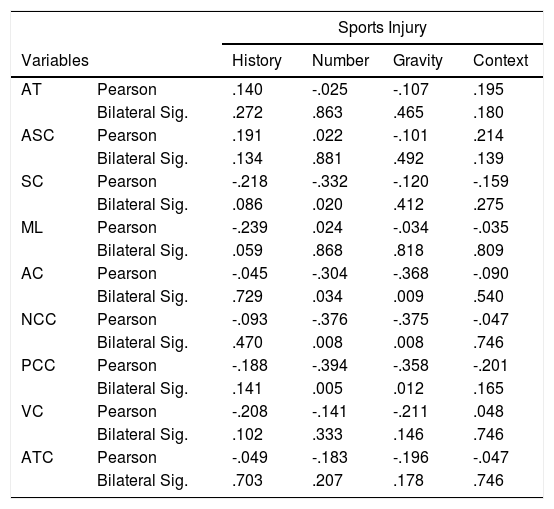The aim of this research is to analyze the relationships between anxiety and the psychological variables of sports performance, with the history of injuries in high-performance sportsmen.
Material and MethodsA cross-sectional and correlational study was designed selecting 63 sportsmen through a stratified random sampling (n= 21 softball, soccer and baseball respectively). To obtain the information and measure the variables, the Questionnaire on Sports Aspects and Injuries, the State -Trait Anxiety Inventory, the State in Competition Anxiety Inventory and the Psychological Inventory of Sports Execution were used. The analysis was carried out using the percentage distribution, mean, standard deviation, skewness, kurtosis, Kolmogorov - Smirnov, HSD Tukey de Anova and the Pearson correlation coefficient (p≤0.05).
ResultsSoftball sportsmen present greater anxiety in competitions (baseball .000; soccer .003) and soccer players have suffered more serious injuries (baseball .008; softball .027). The psychological variables of sports performance that established a relationship with injuries showed an inverse and significant direction such as self-confidence (number of injuries .020), attention control (number .034 and severity .009), negative coping control (number .008 and severity .008) and positive coping control (number .005 and severity .012).
ConclusionsA low self-confidence and limited skills to control attention and emotions, make up the vulnerability of the sportsmen studied, which means that a psychological preparation focused on these psychological processes will contribute to the prevention of injuries.
There have been various theoretical analyses in the definition of the psychological variables that determine success in high performance sports activity. Loehr1, through the systematic study of elite sportsmen, established a total of seven mental skills made up of self-confidence, control of attention, motivational level, control of negative energy, visuoimaginative control, control of positive energy and attitude control, managing to lay the foundations for the search for the ideal psychological profile of a sportsman.
According to Reyes Bossio,2 when reference is made to the psychological profile of performance, it refers to the skills and attributes of sportsman, which accompany their best performances. Several studies3-5 have shown that sportsmen with greater psychological preparation are characterized by high motivation, self-confidence and skills to stay focused on the activity, regulating their emotional states.
In this sense, several authors6 found that sportsmen belonging to Argentine national teams have greater self-confidence, visual-imaginative control and attitude compared to those with a lower competitive level.
The study of these variables in athletes of different sports and levels of mastery, has made possible the characterization of psychological profiles of sports performance, obtaining a tendency towards an inferior development of the control of negative emotions, attention and visuoimaginative,6-10 which It leads to focusing psychological interventions focused on the stimulation of these skills.
The investigation of the psychological characteristics that influence the performance of sportsmen, acquires a connotation of greater relevance and timeliness, due to the need to determine individual and collective subjective factors, which optimize sports performance in competition situations and are related to injuries.
This is because, at present, there is an urgent demand to establish comprehensive injury prevention programs, because several studies7,8,11-15 have shown that some of these psychological variables at low levels of development, can become risk factors, due to the relationships it establishes with the occurrence and severity of the same's.
Research carried out in various sports with athletes of different competitive levels has shown that, some of the psychological variables that influence sports performance, configure the psychological vulnerability to injury, which finds a theoretical basis in the Stress and Injury model16,17.
The results of systematic studies carried out with baseball pitchers have confirmed the relationship of anxiety and psychological skills associated with sports performance, with injury history13,14 and the occurrence of new injuries in competitions15.
However, although the results have shown consistency and stability despite variations in populations and methodological designs, showing a certain degree of convergence with research in individual sports and at different competitive levels7,8,11,12, they have also shown divergences, which has allowed us to infer that the different types of sports and competitive level, may have introduced a bias in the discussion of the results14.
Therefore, despite the fact that multiple studies have shown a relationship between various psychological factors and injuries18-21, the theoretical and methodological dispersion still persists in this field of scientific knowledge, which has been pointed out by various experts on the subject22-24, leaving latent the need for new findings for their systematization.
Based on the still few studies available on the relationship of anxiety and the psychological variables of sports performance with injuries, as well as the divergences in the findings of various research's, a heterogeneous sample of high-performance sportsmen of collective sports was selected with the following objectives:
- 1.
To determine the characteristics of anxiety and the psychological variables of sports performance in the high-performance sportsmen under study.
- 2.
To describe the injury history of sportsmen depending on the sport practiced.
- 3.
To determine the relationship between anxiety and the psychological skills of sports performance, with the injury history of the sportsmen analysed.
A quantitative, non-experimental, cross-sectional and correlational study was carried out. The data collection on the history of injuries and the psychological evaluation coincided with the preparation stage of each of the sports analysed at the beginning of 2020.
The collective sports of the province of Villa Clara that have national championships were studied. A stratified probability sampling was carried out, selecting 63 high-performance sportsmen (n = 21 softball, soccer and baseball respectively). It was determined that there were 21 subjects of each sport because softball only had that number of sportsmen, being the smallest group with respect to the rest. A simple random sampling was performed in the other sports so that the groups were equivalent, giving greater consistency to the statistical analyses. The athletes had a mean age of 22.15 years and a mean sporting experience of 14.49 years.
The Sports Aspects and Injuries Questionnaire25 was used to record the injuries and sociodemographic and sports characteristics.
Trait anxiety was assessed using the Trait Anxiety Scale of the State-Trait Anxiety Inventory (STAI)26. The scale has 20 statements and four options for Lickert-type responses (1 = Almost Never; 2 = Sometimes; 3 = Frequently; 4 = Usually). A Cronbach's alpha coefficient of 0.75 was obtained.
State Anxiety in Competition was evaluated using the Competitive Sport Anxiety Inventory CSAI-227, in its Spanish version.28 It is made up of 27 items distributed in 3 subscales that measure cognitive, somatic anxiety and self-confidence with four Lickert-type response options (1 = Not at all; 2 = A little; 3 = Moderately; 4 = A lot). The total score achieved by each athlete was taken into account, obtaining a Cronbach's alpha coefficient of 0.83.
The psychological variables of sports execution were evaluated using the Psychological Inventory of Sports Execution (IPED).9 This instrument is the adaptation of the Psychological Performance Inventory (PPI)1 and is made up of 42 items distributed in 7 Likert-type response scales (from 1 = Almost Never to 5 = Almost Always). A Cronbach's Alpha coefficient of 0.71 was obtained for the Self-confidence factor, 0.75 for Negative Coping Control, 0.71 for Attention Control, 0.78 for Visuo-imaginative Control, 0.68 for Motivational Level, 0.69 Positive Coping Control and 0.71 for Attitudinal Control.
Descriptive statistics of central tendency and dispersion (mean and standard deviation), the empirical distribution of frequencies and normality analysis using asymmetry, kurtosis and the Kolmogorov-Smirnov test were used. The post-hot test, HSD Tukey de Anova was used for the comparison of the psychological variables and the history of injuries between the groups that make up the sample. Pearson's correlation coefficient was applied, whose values closer to -1 and 1 indicate the greatest strength of association between the variables. In any case, a statistical reliability level of 95% (p ≤ .05) was considered. For this analysis, the IBM SPSS software package for Windows (version 25.0, SPSS Inc.) was used.
For the research, the informed consent of the selected sportsmen was obtained, the approval of the Scientific Council of the Provincial Center of Sports Medicine of Villa Clara and the endorsement of the Research Ethics Committee. At all times, they acted in accordance with the ethical precepts contained in the Declaration of Helsinki.
ResultsTable 1 shows the results of the psychological evaluation carried out on the sportsmen. It is observed that the psychological variables have a normal distribution. Trait anxiety reaches adequate mean values as does state anxiety in competition. Attitude control, self-confidence, motivational level and positive coping control are the variables that present the highest score.
Status of psychological variables and normality test.
Note: AT= Anxiety Trait, ASC= Anxiety Status in Competition, SC= Self-Confidence, ML= Motivational Level, AC= Attention Control, NCC= Negative Coping Control, PCC= Positive Coping Control, VC= Visuoimaginative Control, ATC= Attitude Control, SD= Standard Deviation, K-S= Kolmogorov– Smirnov for a sample.
Table 2 shows that the psychological variables reach different values depending on the sport being analysed. However, when making the multiple comparison, it is evidenced that only state anxiety in competition establishes statistically significant differences, being higher in softball sportsmen.
Comparison of psychological variables between sports.
Note: AT= Anxiety Trait, ASC= Anxiety Status in Competition, SC= Self-Confidence, ML= Motivational Level, AC= Attention Control, NCC= Negative Coping Control, PCC= Positive Coping Control, VC= Visuoimaginative Control, ATC= Attitude Control.
Table 3 shows the results of the relationships between the psychological variables. It was obtained that not all correlate with each other. Specifically, it is observed that trait and state anxiety do not establish a relationship with psychological skills, but they do correlate between them in a positive way, which indicates that greater trait anxiety constitutes a risk to trigger greater anxiety during competitions. In addition, it is appreciated that self-confidence establishes positive relationships with the rest of the sports performance variables and a high interdependence between the rest.
Correlation between the psychological variables studied.
Note: AT= Anxiety Trait, ASC= Anxiety Status in Competition, SC= Self-Confidence, ML= Motivational Level, AC= Attention Control, NCC= Negative Coping Control, PCC= Positive Coping Control, VC= Visuoimaginative Control, ATC= Attitude Control.
Table 4 shows that the majority of sportsmen have suffered injuries, although it is more frequent that they are less serious. The context where they are produced with the greatest predilection is in competition, which denotes the importance of their prevention in obtaining high sports performance and results.
Description of sports injury history.
Note: N= Number; PD= Percentage distribution.
Table 5 shows that there are no statistically significant differences regarding the fact of having been injured, nor the context where the injuries occur depending on the sport practiced, however, soccer sportsmen present a greater number and severity of injuries than softball and baseball sportsmen.
Comparison of injury history between sports.
Note: AI= Antecedent of injury, NI= Number of Injuries, SI= Severity of Injury, IOC= Injury Occurrence Context.
Table 6 shows that self-confidence is negatively related to the amount of injuries suffered and in a similar way happens with attention control, negative and positive coping control respectively, although these last variables are also related to gravity.
Correlation between psychological variables and injury history.
Note: AT= Anxiety Trait, ASC= Anxiety Status in Competition, SC= Self-Confidence, ML= Motivational Level, AC= Attention Control, NCC= Negative Coping Control, PCC= Positive Coping Control, VC= Visuoimaginative Control, ATC= Attitude Control.
In a general sense, the sportsmen analysed show more strengths than weaknesses in the psychological profile of sports performance, since only the control of attention, the control of negative and visuoimaginative coping present low scores compared to the rest of the psychological skills. This result is similar to those found in several previous studies.6-10,13-15 The comparative results indicate that these psychological variables have a relatively homogeneous state of development among the sportsmen studied, since only anxiety in competition was significantly higher in the softball sportsmen.
The independence between anxiety and the psychological variables of sports performance, as well as the high level of interdependence of the latter, can be compared with the results obtained in a study previously carried out in baseball pitchers of the same competitive level,14 where it was obtained by proximity analysis, that the psychological variables were agglomerated forming a homogeneous group differing from the trait and state anxiety, allowing to identify their systemic character.
On the other hand, the high presence of sportsmen with a history of injuries, most of which have been mild and have occurred predominantly in competitions, coincides with the results of the specific research background taken into account for the current study.10,13-15
In addition, the occurrence of injuries regardless of sport confirms the results of several studies that have shown high prevalence rates in all sports modalities, which has led to the suggestion that injuries are inherent to sport and the main scourge in this human activity.29,30
Specifically, the difference in the amount of injuries suffered depending on the type of sport may be given by their differentiating characteristics, since despite the fact that soccer is played with the ball through collective interaction, its differentiating feature for the frequency of injuries is that it occurs in direct opposition.
The relationships between the psychological characteristics of these athletes and the injuries showed that trait anxiety is not associated with a history of injuries, coinciding with the results obtained by a previous research31, at the same time that they differ from other studies,13,14,32 where a relationship was obtained with the amount of injuries suffered.
There was also no relationship between state anxiety in competition and injuries, coinciding with several similar research carried out with samples of different sports,7,8,31 but at the same time they differ from the results obtained by studies carried out in baseball pitchers,13,14 and in other sports.33,34
In a general sense, the divergent results obtained in the present study on the relationships of anxiety with injuries, confirm the approach made by several authors14 by stating that the relationship between these variables varies considerably between different sports and sportsmen.
The association of self-confidence with the number of injuries, allows us to infer that sportsmen who trust little in their own skills to achieve sporting success have suffered more injuries. This result has been found by several previous studies,11,13,14,35 being one of the variables with greater consistency over time as the populations of sportsmen and the methodological designs of the research carried out to date vary.
Another of the more consistent results is the one obtained regarding the inverse relationship of negative coping control and injuries, coinciding with several studies7,8,12-14 indicating that athletes who have few skills to control negative emotions like competition anxiety itself, they tend to injure themselves more frequently, or are simply more susceptible to injury.
The result on the control of attention, coincides with two studies in a specific way, as it is negatively related to the number of injuries7 and their severity,13 however, other authors found no relationship between these variables 8,11. This finding is based on the Stress and Injury model,16,17 which establishes that the sportsmen's maladaptive response to a potentially stressful situation is characterized, among other psychophysiological aspects, by an increase in distractibility leading to injury.
Taking into account that attention control establishes a direct relationship with self-confidence and negative coping control, it is inferred that the sportsmen studied who present a lower ability to maintain the attention focus during situations of tension in the game, also have a low level of self-confidence and little skills to control negative emotions from these adverse situations, so vulnerability to injury is high, because precisely the control of attention and negative coping are the main weaknesses psychological of these sportsmen.
On the other hand, the sportsmen analysed who have low positive coping control have been injured more frequently and more seriously, partially coinciding with several studies,7,11 since they found that a lower control of positive emotions is associated with a greater number of injuries suffered, but at the same time it disagrees with several research12,14 that did not obtain a relationship between the variables.
As with several previous studies carried out with samples from various sports, the visuoimaginative control did not show a relationship with injuries,7,8,11,12 differing with the results obtained in baseball pitchers 13,14.
In addition, it was found that attitude control is not related to the injuries suffered, contrasting when it coincides with several studies11-14 and disagreeing with other authors 7,8 that they did find such a relationship.
Finally, the absence of a relationship between the motivational level and the history of injuries, coincides with all the studies that evaluated motivation using the IPED7,8,11,13,14 which also found no relationship between these variables.
The results confirm the relevance of the study of the psychological characteristics of athletes, not only to obtain psychological performance profiles and guide psychological intervention based on excellent sports performance, but also to understand the relationships that are established in the intra-subjective dynamics of sportsmen from a holistic approach.
Conceiving the sportsmen's personality as the highest level of structuring psychological processes from a dialectical position, allows the sport psychologist to save time and resources in the process of psychological preparation for competitions, since the state of a skill is always related to others in a positive sense, although the strength of this correlation is not homogeneous for the rest of the variables because they follow a hierarchical arrangement.
The above results become more relevant if the high presence of injuries in sportsmen and the marked biomedical focus on their prevention and rehabilitation are taken into account, despite the fact that scientific evidence points increasingly strongly towards the role of psychological processes in the occurrence of injuries and the recovery process and return to the field of the injured sportsman.
Understanding the relationships that are established between psychological variables and injuries from a holistic knowledge of the subjective characteristics of the sportsman, allows making inferences about their vulnerability and guides the intervention to be carried out in a timely, expeditious and preventive manner.
In this case, stimulating the control of negative emotions and the control of attention is pertinent in a group manner, however, when taking into account the history of injuries, it is necessary to also work with the control of positive emotions, to generate a higher level of self-confidence in athletes who have suffered a greater number of more serious injuries.
The results are useful for psychologists, trainers and sports doctors, but they are considered of greater value for the sportsman themselves at the individual and collective level, since they make it possible to activate the processes of conscious regulation in training and competitions, optimize their performance and preserve your health in potentially stressful situations.
Despite the foregoing, the study of a representative sample of high-performance Cuban sportsmen from national teams is considered pertinent, as well as employing explanatory and predictive analytical methods through longitudinal studies, in order to design psychological preparation programs aimed at providing the sports performance and prevent the occurrence of injuries and their subjective consequences for the sportsman. This need is formulated from the limitations that the current research presents to fulfil such purposes.
The results obtained have not been published or presented at events or conferences.




